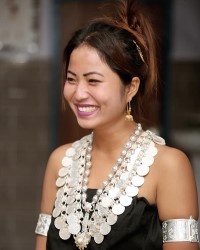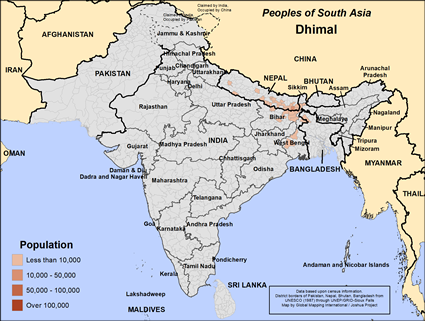Dhimal in India

Photo Source:
Munal Chaudhary - Wikimedia
Creative Commons
|

Map Source:
People Group data: Omid. Map geography: UNESCO / GMI. Map Design: Joshua Project.
|
| People Name: | Dhimal |
| Country: | India |
| 10/40 Window: | Yes |
| Population: | 5,100 |
| World Population: | 33,100 |
| Primary Language: | Maithili |
| Primary Religion: | Hinduism |
| Christian Adherents: | 0.00 % |
| Evangelicals: | 0.00 % |
| Scripture: | New Testament |
| Ministry Resources: | Yes |
| Jesus Film: | Yes |
| Audio Recordings: | Yes |
| People Cluster: | South Asia Hindu - other |
| Affinity Bloc: | South Asian Peoples |
| Progress Level: |
|
Introduction / History
Most Dhimal people live in mountainous nation of Nepal. Some also live in the Indian states of West Bengal and Bihar. The Dhimal are an indigenous people whose former lifestyle involved hunting and gathering in the forests of the Indian subcontinent. Today most Dhimal work as landless, agricultural laborers. Most Dhimal live in poverty with little hope for the future. Illiteracy is a major problem for the Dhimal, especially among women. As a tribal people, the Dhimal are outside of the Hindu caste system. Many Hindus therefore will not associate with them.
The main language of the Dhimal depends upon where they live. They speak Rangpuri, Maithili, Dhimal and Hindi. Of these, Maithili is their most common language.
What Are Their Lives Like?
The Indian government has curtailed Dhimal's former livelihood of hunting and gathering. The Dhimal work long hours in fields owned by others. Besides working in the fields, Dhimal women weave baskets, mats and rugs for cash. If crops fail, the Dhimal face starvation. Dhimal children are often not welcomed at government schools so their cycle of poverty continues.
The main foods of the Dhimal are rice and grains. They are not vegetarians but as Hindus they will not consume beef. Meat is often reserved for special occasions.
The Dhimal marry within their group. Families arrange marriages. Sons inherit what little property their father owns.
What Are Their Beliefs?
The Dhimal consider themselves Hindus but orthodox Hindus view them as more animists than members of their religion. The Dhimal worship and serve Chaitanya and Nityananda, Hindu mystics of the 16th century, as their patron deities. The Dhimal also worship other deities like Buda Thakur, Sadi Buri, and Kali, the goddess of sex and destruction.
The main yearly holidays of the Dhimal people are Holi, the festival of colors, Diwali, the festival of lights, Navratri, the celebration of autumn and Rama Navami, Rama's birthday.
There are a few hundred believers among the Dhimal.
What Are Their Needs?
The Dhimal have huge needs. They need help in educating their children and in learning new job skills. They need access to electricity, indoor plumbing and modern medicine. Most of all, the Dhimal need to hear and understand the life-changing message of Jesus Christ who alone can forgive their sins and give them hope.
Prayer Points
Pray for the Holy Spirit to give the Dhimal people in India teachable and understanding hearts.
Pray that a strong movement of the Holy Spirit will bring entire Dhimal families into a rich experience of God's blessing.
Pray for teams of believers to do sustained, focused prayer for the Lord to open the hearts of Dhimal family leaders to experience God's blessing through a movement of family-based discovery Bible studies.